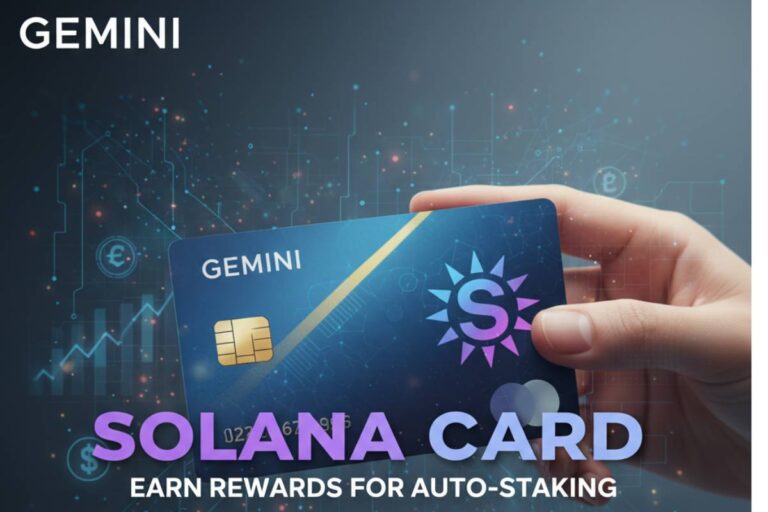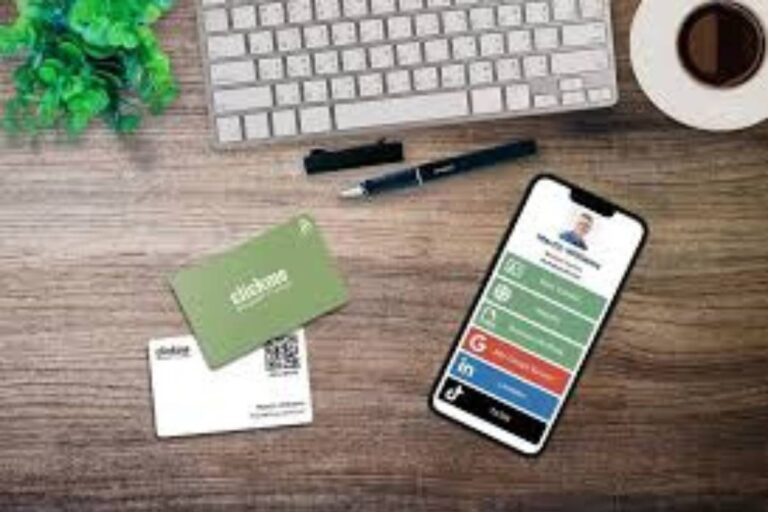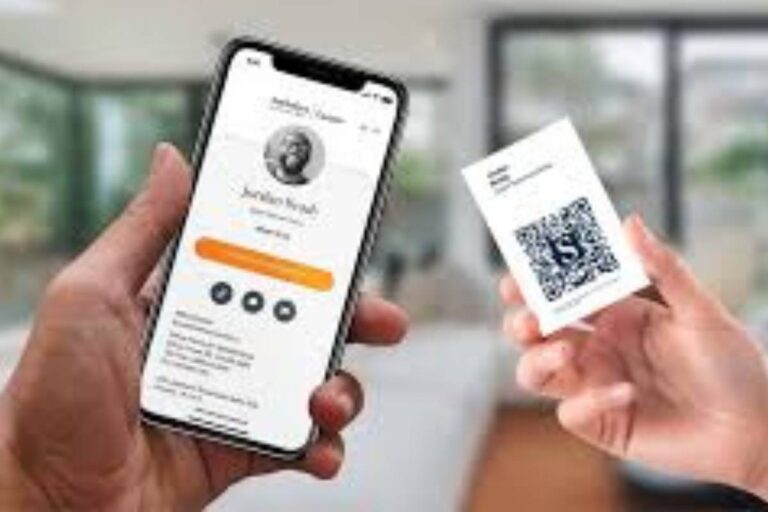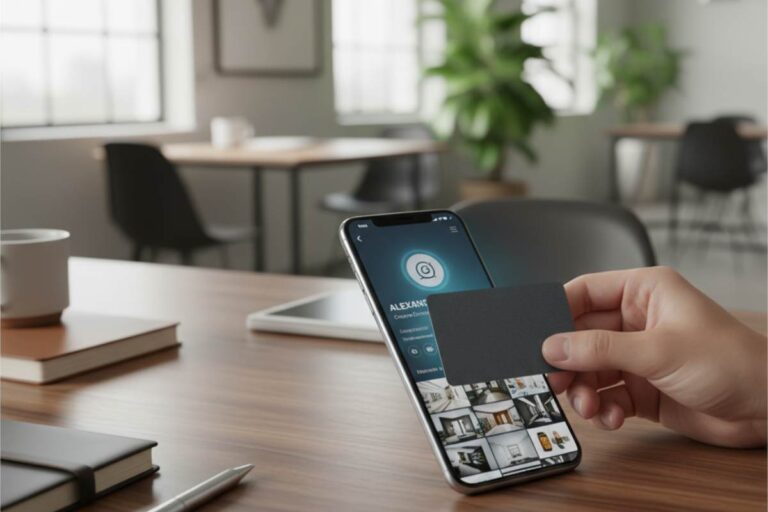Professional networking is being revolutionized by digital business cards, but selecting the appropriate technology can be challenging. Although NFC (Near Field Communication) and QR codes are both attractive substitutes for conventional paper cards, each has unique benefits and drawbacks that could make or break your networking plan.
The stakes are higher than you might imagine: digital alternatives are converting contacts at 300% higher rates than traditional ones, and 88% of traditional business cards are thrown in the trash within a week. Which technology, then, merits a spot in your wallet?
Comprehending the Technologies
Why NFC Business Cards Are Effective
NFC business cards use embedded microchips that use electromagnetic waves to communicate with smartphones. Your contact details, social media profiles, and website links are instantly sent to the person’s device when they tap their phone against your card, which is typically within 4 centimeters.
With the majority of contemporary smartphones, the technology functions flawlessly. Because NFC is built into both iOS and Android devices, recipients don’t need to download extra apps. Your business card functions similarly to a tiny computer that can communicate with smartphones.
The Operation of QR Code Cards
Business cards with QR codes adopt a completely different strategy. These cards feature a scannable matrix barcode that directs users to your digital profile when captured on camera. The method works with almost any smartphone made in the past ten years, but it requires launching a camera app and focusing on the code.
The data capacity of QR codes is especially clever; they can store up to 3 kilobytes of information, which is nearly six times more than most NFC tags. This implies that you can incorporate more intricate information than just straightforward redirects into the code itself.
The Battle of the User Experience
Convenience and Speed Factor
NFC cards dominate in terms of sheer convenience. The tap-and-go feature, which requires only a quick touch and no camera positioning or app switching, feels almost magical. In crowded networking events, where fumbling with cameras becomes awkward, this seamless experience really shines.
QR codes necessitate more intentional behavior. After launching their camera app and properly positioning their camera, users must wait for recognition. Even though it usually only takes three to five seconds, this small friction can affect adoption rates, particularly for recipients who are less tech-savvy.
But there’s a catch with NFC. Due to the requirement for close proximity, both devices must be precisely aligned. NFC sensors are positioned differently in different phone models, which can occasionally result in awkward positioning attempts.
Device Compatibility
Here’s where QR codes are most useful. Almost all smartphones have built-in cameras that can scan QR codes. Anyone can access your information without any issues, regardless of whether they have the newest iPhone or a cheap Android phone from 2019.
Despite being widely used, NFC compatibility is not always present. NFC chips are found in the majority of smartphones made after 2014, though older models and less expensive models occasionally do not. Another possible obstacle is that users sometimes turn off NFC to save battery life.
The effect in the real world? While almost everyone can scan QR codes, you may find that 10–20% of attendees at networking events are unable to access NFC content right away.
Security Points to Remember
The Integrated Security of NFC
NFC technology transmits data in an encrypted manner, providing better security. Unauthorized interception is practically impossible due to the incredibly short communication range (4 centimeters). To intercept data, hackers would actually have to touch your card, which isn’t very practical.
Additionally, this proximity requirement stops unintentional data sharing. You have total control over when and how your information is shared because it only transmits when your card is purposefully tapped.
Vulnerabilities of QR Codes
There are additional security risks with QR codes. Malicious actors can write phony codes that cause malware to download or reroute users to phishing websites. Some users are reluctant to scan unknown codes because of this risk, even though it mostly affects public QR codes (such as those on restaurant tables).
According to studies, more than 40% of users say they are hesitant to scan QR codes because they are worried about security. Even if your codes are completely secure, this psychological barrier may affect how effective you are at networking.
To reduce these risks, trustworthy digital business card platforms use security features like secure hosting and HTTPS encryption.
Breakdown of Cost Analysis
Initial Investment Needs
The distinctions become glaring at this point. The cost of QR code generation is almost zero; many platforms provide free QR code generation, and printing expenses are low whether or not you include a QR code in pre-existing designs.
The initial outlay for NFC business cards is higher. While high-end materials like metal or wood can cost $300–600 per card, basic NFC cards start at about $35–50. The manufacturing cost of embedded chip technology is simply higher.
Proposition for Long-Term Value
When longevity is taken into account, the cost equation changes. Both technologies allow for unlimited updates without requiring reprinting; for example, if you change your job title or phone number, your digital profile will update immediately. This removes the ongoing expenses that eventually drive up the cost of conventional business cards.
Physically, NFC cards usually last longer. Compared to paper-based QR code cards, they are more resilient to wear and tear because they are made of sturdy plastic, metal, or composite materials. Durability variations, however, are less noticeable when printing QR codes on premium cardstock.
Aesthetic Impact and Design
Difficulties with Visual Integration
Interesting design conundrums are presented by QR codes. Modern QR codes still take up a lot of visual space on your card, even though they can include logos and color schemes. It can be difficult for some designers to incorporate these matrix patterns into tasteful, polished layouts.
More design flexibility is provided by NFC cards. Because it is embedded in the card material, the chip is invisible. This preserves digital functionality while enabling cleaner, more conventional business card designs. Beautiful designs can be made without any obvious technological components.
Opportunities for Branding
Though in different ways, both technologies offer distinctive branding opportunities. Your brand’s colors can be used to personalize QR codes, and you can even add tiny logos inside the code. Some businesses incorporate the QR code into their visual identity by using it as a design element.
NFC cards are excellent at producing wow moments that people remember. It shows technological sophistication and enhances your brand when someone taps your card and their phone responds right away. At networking events, this element of surprise frequently leaves a lasting impression.
Applications Particular to Industry
Industries Driven by Technology
Both solutions are very effective in the e-commerce, marketing, and technology sectors. Recipients usually carry NFC-enabled devices, and these industries anticipate digital innovation. Rather than being limited by technology, the decision is frequently based on aesthetic preferences and financial constraints.
While established corporations may opt for QR codes due to their cost-effectiveness and wider compatibility, startups and tech companies often favor NFC because of its innovative appearance.
Conventional Business Domains
Different factors are taken into account in conservative industries such as real estate, finance, and law. Given their increasing prevalence in dining establishments and retail settings, QR codes may encounter less opposition. Adoption rates are aided by visual familiarity.
Despite its impressiveness, traditional business professionals who prefer simple solutions may find NFC technology too complicated. But this differs greatly by demographic and geography.
The Hybrid Method
The Best of Both Worlds
More and more progressive professionals are selecting dual-technology cards with both NFC chips and QR codes. This hybrid strategy gives recipients a choice in how they access your information while guaranteeing maximum compatibility.
For consultants or salespeople who network across a range of age groups and industries, the approach is especially effective. Some recipients who are tech-savvy can scan the QR code, while others can tap the NFC chip.
Considerations for Implementation
Careful design planning is necessary for hybrid cards. Along with the additional expense of both technologies, you’ll need to make room for the QR code without sacrificing aesthetic appeal. For complete compatibility, many professionals believe the investment is worthwhile.
- Strategic placement: QR code on the back while maintaining a clean front
- Integrated design: Combining both elements into a single, uncluttered design
- Cost consideration: Additional expense of both technologies
- Maximum compatibility: Ensuring all devices can access your information
Coming to a Decision
Evaluate Your Networking Environment
Think about your usual networking locations and methods. Due to its speed and convenience in crowded settings, NFC may be preferred by professionals who attend a lot of conferences. Due to their universal compatibility, QR codes may be preferred by those who network across various age groups or industries.
Your budget is also very important:
- QR codes provide substantial cost savings for large teams
- NFC’s premium feel may justify a higher investment for individual use
- Consider long-term replacement costs and update frequencies
Taking Future-Proofing Into Account
Both technologies are still developing quickly. With 89 million Americans routinely scanning codes, the use of QR codes increased by 300% during the pandemic and is still high today. This widespread use indicates that QR-based solutions will last.
The popularity of contactless payments and growing smartphone compatibility are driving the growth of NFC adoption. Longer-term branding benefits may result from the technology’s more futuristic feel.
Best Practices for Implementation
Improving the Performance of QR Codes
For best results, adhere to these recommendations if you decide to use QR codes:
- Size matters: Codes must be at least 1 inch square for dependable scanning
- Include succinct instructions, such as “Scan to connect,t” to assist new users
- Extensively test codes in various lighting conditions and smartphone models
- Ensure landing pages load quickly on mobile devices to avoid user frustration
Optimizing NFC Efficiency
The best results from NFC cards come from educating the recipients about the technology:
- Use simple “Tap to connect” instructions to increase adoption rates
- Consider demonstrating the procedure during first meetings to overcome hesitation
- Ensure recipients understand where to tap on the card
- Include subtle visual cues indicating the best contact point
Assessing ROI and Success
Monitoring Engagement Indicators
Compared to traditional business cards, both technologies provide valuable analytics capabilities:
- QR codes typically provide: Device information, timing data, and scan locations
- NFC analytics include: Similar metrics, plus unsuccessful tap attempts and proximity interactions
- This data helps determine which networking gatherings result in the highest engagement levels
Determining Long-Term Worth
Beyond the initial purchase price, take into account the overall cost of ownership:
- Replacement costs for lost cards
- Update frequency requirements
- Value of analytics data for networking optimization
- Conversion rate advantages (300% higher than traditional paper cards)
Many professionals discover that even pricey NFC cards pay for themselves in 12 to 18 months due to increased networking efficiency.
Looking Ahead
The market for digital business cards is expected to grow at a rate of 10–12% per year. Both NFC and QR code technologies are constantly developing, with new features and functionalities appearing on a regular basis.
Instead of solely embracing one technology, shrewd professionals are increasingly selecting solutions based on particular networking contexts. By combining both technologies, the hybrid approach gives you the most flexibility and ensures that your networking toolkit is ready for the future.
The key is to match technology to your unique networking needs and professional context, whether you opt for the universal compatibility of QR codes, the seamless elegance of NFC, or a hybrid solution that combines both advantages. The days of scrambling for paper cards are coming to an end; the question is not whether to go digital, but rather which digital route best suits your networking objectives.
















